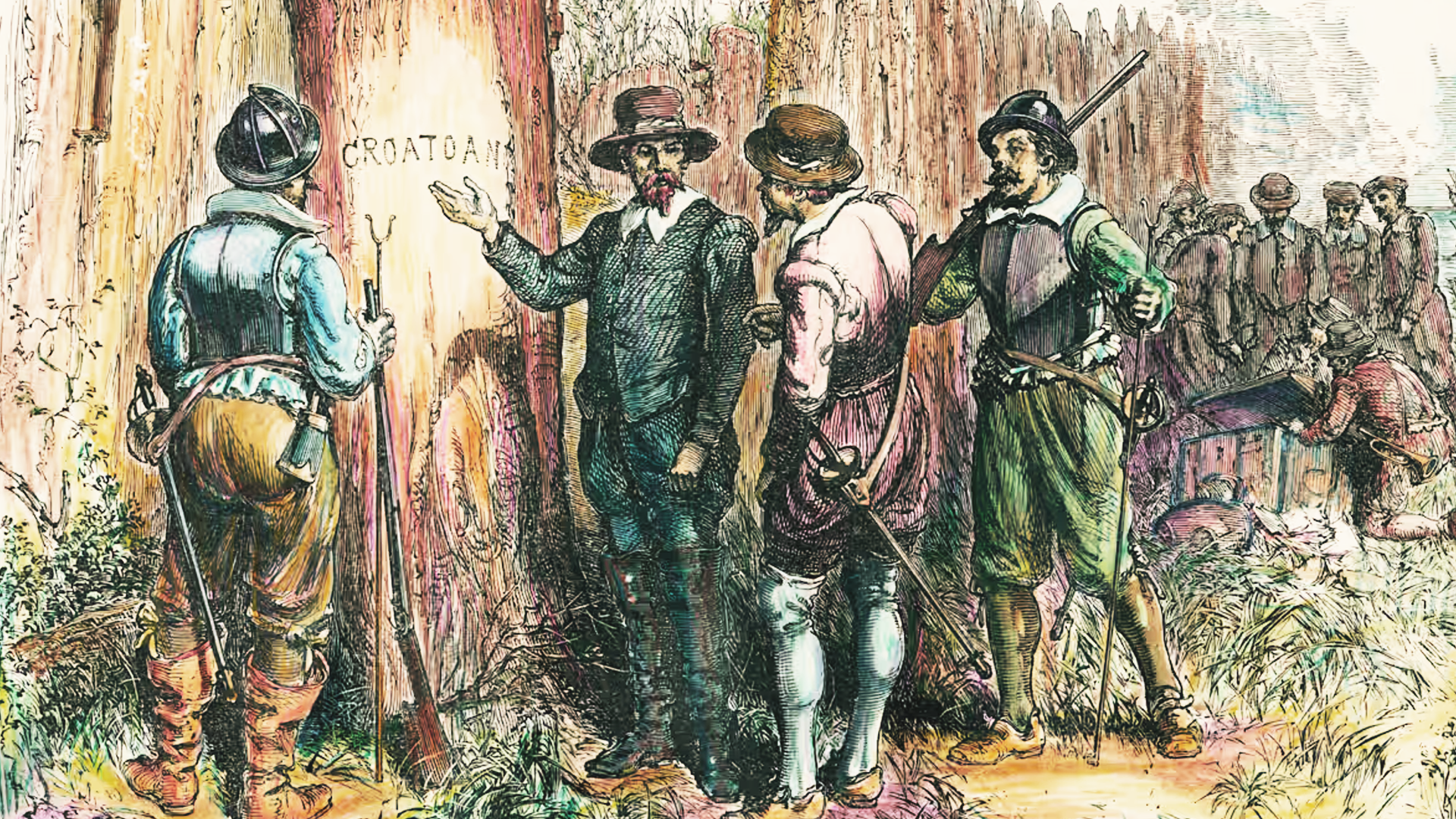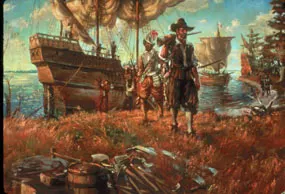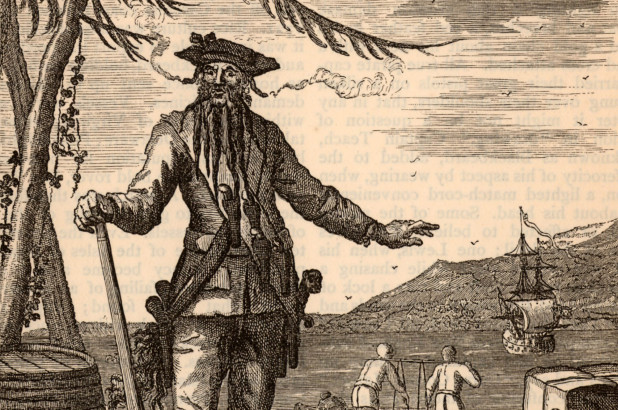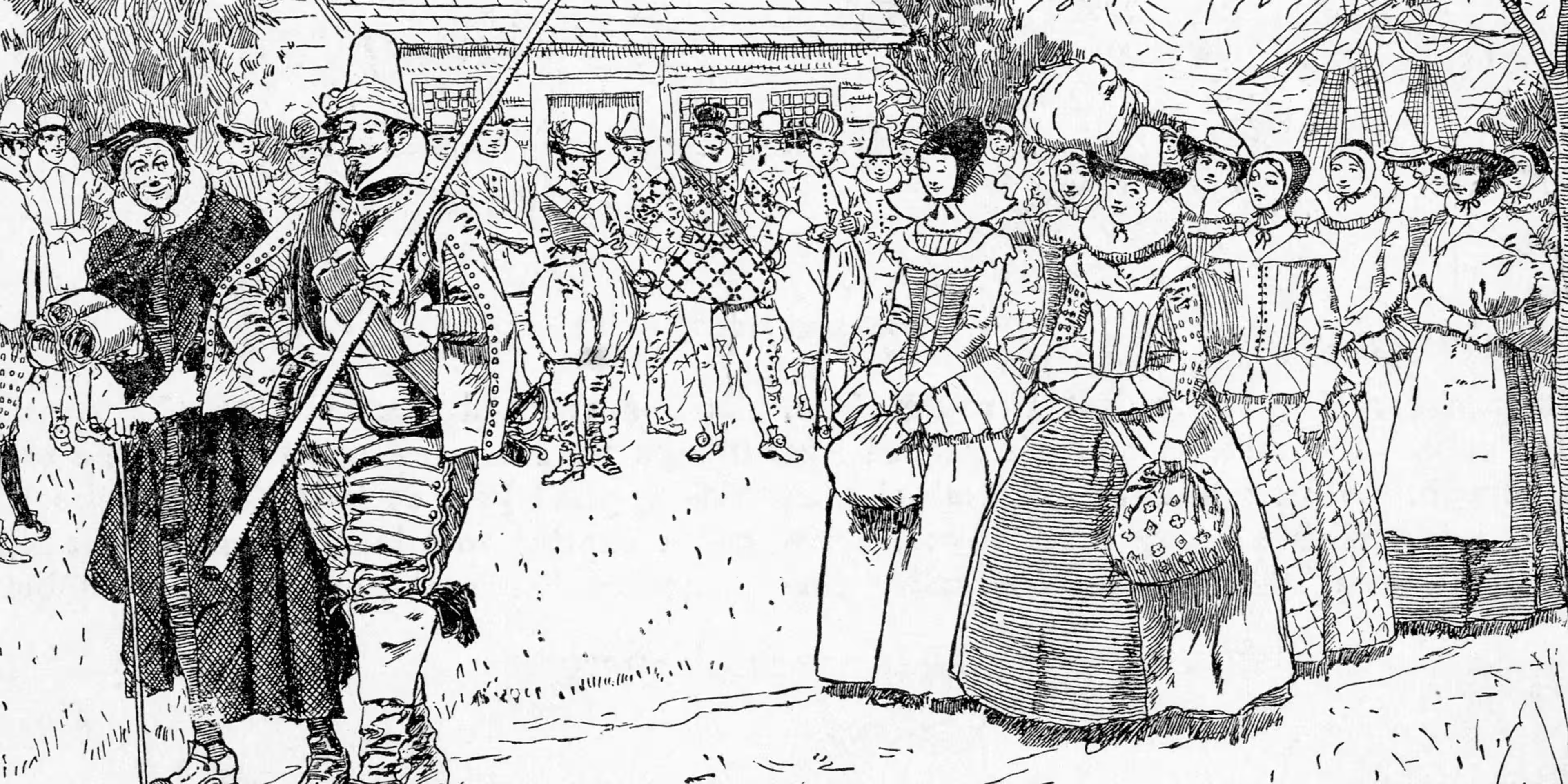English Colonization: Roanoke, Jamestown, and Early Settlements

Historic recreation of Jamestown settlement with wooden fort and people in colonial dress.
The Dive
Before the English planted permanent roots in North America, they dabbled in colonization with mixed results, and some eerie mysteries. Case in point: the Lost Colony of Roanoke. Established in the 1580s on an island off the coast of present-day North Carolina, this early settlement vanished without a trace. When Governor John White returned from England in 1590, he found the camp deserted, the word “CROATOAN” carved into a fence post, and no sign of his family or fellow colonists. Extreme drought, local alliances, or forced migration may have played a role, but the full story remains one of America’s oldest unsolved mysteries.
After Roanoke, English ambitions turned south. In 1607, a group of 104 settlers arrived in Virginia and founded Jamestown, the first permanent English colony. It was no paradise. Built in a swampy, mosquito-ridden area and surrounded by the powerful Powhatan Confederacy, the colony struggled with food shortages, disease, and poor leadership. Many colonists were gentlemen unaccustomed to manual labor and ill-prepared for survival. By the winter of 1609–1610—known as the 'Starving Time'—colonists resorted to eating leather and, according to some accounts, even each other.
Enter Captain John Smith. A tough leader with battlefield experience, Smith forced colonists to work, established fragile trade with the Powhatan, and helped stabilize the colony—until a gunpowder injury sent him back to England. Relations with Indigenous peoples, especially under Powhatan’s successor Opechancanough, deteriorated quickly. English expansion into Native territory, crop demands, and kidnapping of Powhatan’s daughter, Pocahontas, added fuel to the fire. A brief peace came with Pocahontas’ marriage to John Rolfe, the man who introduced a lucrative strain of tobacco that turned Jamestown into a cash cow—and a magnet for more settlers and enslaved labor.
In 1619, three major shifts defined colonial life: (1) the arrival of the first documented Africans in Virginia, laying the foundation for race-based slavery; (2) the introduction of the first representative assembly, the House of Burgesses; and (3) the recruitment of English women to help establish permanent families. These moves turned Jamestown from a commercial experiment into a colonial society—one defined by tobacco profits, patriarchal governance, and increasing inequality.
Meanwhile, to the north and south, other English ventures bloomed. In present-day North Carolina, settlers trickled down from Virginia and officially established the town of Bath in 1705—North Carolina’s first town. Located along the Pamlico River, Bath was a hub of shipbuilding and trade. It was also home (or hideout) to the infamous pirate Blackbeard, who operated with suspicious ease under the eye of Governor Charles Eden. Local legend and historical fact blur in Bath, but what’s clear is that the town played a central role in the colony’s economic and political beginnings.
Unlike the compact, covenant-driven towns of New England, Southern colonies like Virginia and the Carolinas adopted more aristocratic models of governance. In the Carolinas, land was granted by the English king to eight Lords Proprietors, who envisioned a society of landed elites ruling over enslaved workers. Their Fundamental Constitutions of Carolina aimed to entrench hereditary nobility and centralized control—an experiment that didn’t go as planned but left its imprint on Southern political culture.
Colonial governance evolved unevenly. The Mayflower Compact in New England emphasized collective agreement and early democratic ideals. In contrast, Southern colonies were driven by elite-controlled legislatures, economic exploitation, and large landholdings. Joint-stock companies like the Virginia Company financed exploration and profited from resources like tobacco, fish, and furs, tying colonial survival directly to the global economy.
The early English colonies weren’t just seeds of a future nation—they were battlefields of clashing empires, cultures, and ambitions. Colonization brought new trade networks, cash crops, and institutions—but it also unleashed waves of displacement, violence, and forced labor that echoed across centuries. And it all started with a lost colony, a swampy fort, and a whole lot of hardship.
Why It Matters
The story of English colonization isn’t just about dusty forts or pirate legends—it’s about the formation of political systems, economic power structures, and racial hierarchies that shaped America’s future. Understanding the origins of Jamestown, the disappearance of Roanoke, and the founding of towns like Bath reveals how colonization was both a bold venture and a brutal transformation. These early settlements were the testing grounds for ideas about democracy, labor, property, and power—ideas that continue to define our society today.
?
Why do you think the Roanoke colony failed while Jamestown survived?
How did tobacco shape the economy and labor systems of the early colonies?
What were the different approaches to governance in New England and the Southern colonies?
How did the Powhatan Confederacy respond to English colonization?
What role did joint-stock companies play in colonization—and what does that tell us about early capitalism?
How did the arrival of enslaved Africans in 1619 change the trajectory of the American colonies?
What can the history of Bath, NC tell us about life beyond Virginia during early colonization?
Dig Deeper
Relations between the early English colonists and the Native people they encountered. From fragile trade alliances to brutal conflict, this episode covers Powhatan, Pocahontas, and the patterns of expansion and resistance.
Experts look into one of the biggest unanswered questions in American history—what happened to the colony of Roanoke?
Related

Joint-Stock Companies: Capitalism, Colonization, and Risk
Without joint-stock companies, there might be no Jamestown, no thirteen colonies—and no United States. These early capitalist ventures let investors fund risky New World settlements without bankrupting the Crown.

Life and Society in the Colonial Carolinas
Explore the rise of plantation agriculture, slavery, class divisions, and the shaping of daily life in the colonial South—particularly in North Carolina and South Carolina.

The 13 Colonies: Seeds of a New Nation
How did thirteen scattered colonies along the Atlantic coast grow into the foundation of a new nation?
Further Reading
Stay curious!



